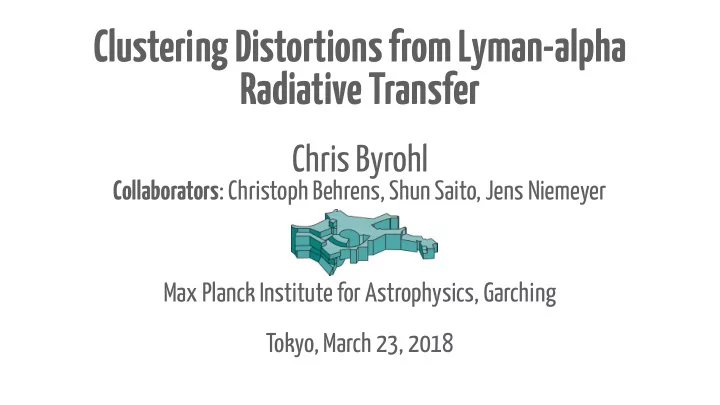

Clustering Distortions from Lyman-alpha Radiative Transfer Chris Byrohl Collaborators : Christoph Behrens, Shun Saito, Jens Niemeyer Max Planck Institute for Astrophysics, Garching Tokyo, March 23, 2018
Motivation ● Ly- α: Prominent emission line for high-z galaxies Opportunity : ● Low redshifts (2<z<3.5): Cosmology with HETDEX ● High redshifts: Complementary reionization probe Theoretical Challenge : ● Resonant line with high optical depths →Complex radiative transfer → Numerical simulations RT Distortion #1 : arXiv:1710.06171 (C. Behrens, CB et al.) RT Distortion #2 : in prep ( CB , S. Saito et al.)
Reminder: Redshift Space Distortions (Reid et al., 2012) Kaiser effect : Squashing due to coherent motion on large scales Fingers-of-God effect : Elongation due to random motion on small scales
Radiative Transfer Distortions Classic Redshift Radiative Transfer Space Distortions Distortions Kaiser effect RT Distortion #1 Squashing due to coherent Elongation due to coherent motion on large scales attenuation on large scales Fingers-of-God effect RT Distortion #2 Elongation due to random Elongation due to random motion on small scales spectrum on small scales
RT Distortion #1 Elongation due to due coherent attenuation on large scales Numerical Simulations Numerical Simulations RT Distortion #2 Elongation due to random spectrum on small scales
Numerical Simulations – Illustris ● Set of cosmological simulations run with AREPO for DM+BM physics. ● Public snapshots/halo catalogs ● Voronoi Octree for RT simulation → Illustris Simulation
Numerical Simulations – Radiative Transfer ● Monte Carlo Approach ● Spawn weighted photons according to local luminosity and spectrum ● At scatterings, compute attenuated luminosity reaching observer.
Numerical Simulations – Emitter Assumptions ● Assign to luminosity and spectrum to (sub)halos: – All emission in sub(halo) center – – Gaussian with – Cut out ISM, no dust, no escape fraction...
Numerical Simulations – Visual Results
RT Distortion #1 Elongation due to due coherent attenuation on large scales Numerical Simulations RT Distortion #2 Elongation due to random spectrum on small scales
RT Distortion #1 – Introduction Theory ● (Zheng et al., 2011) fjnd anisotropic clustering due to a Selection Effect Observation ● (Croft et al., 2016) observe similar clustering effect ● Problem for Ly surveys, α such as HETDEX?
RT Distortion #1 – Explanation ● Attenuation correlates with: Density (isotropic) Velocity gradient (anisotropic) ● Resulting clustering signal: Bias ⬊ Clustering along line of sight ⬊ ⬈ perpendicular (Zheng et al., 2011)
RT Distortion #1 – Results: Mock Observations
RT Distortion #1 – Results: LSS correlations ● Defjne the observed fraction as ● Finding no correlation with LSS no clustering distortion →
RT Distortion #1 – Results: LSS correlations ● Try to reproduce ZZ10/11: – Lower resolution – Adjust emitter model
RT Distortion #1 – Results: Clustering Signal ● z = 5.9 ● Resolution independent at lower redshifts ● Reproduce prior fjndings, but numerical effect, nevertheless physical implications.
RT Distortion #1 – Further Explanation ISM ISM ISM CGM CGM IGM 0 0 0 ● Attenuated fuu frequency dependend → Resolving the CGM scale matters … and need good modeling of ISM
RT Distortion #1 – Further Explanation
RT Distortion #1 – Summary ● Anisotropic RT distortion due to velocity gradient’s impact on attenuation on large scales. ● For given setup, effect shown to be numerical. ● Does not euist for ‘low’-z good for HETDEX, etc. → ● Euistence at ‘high’-z depends on small-scale spectral modeling.
RT Distortion #1 Elongation due to due coherent attenuation on large scales Numerical Simulations RT Distortion #2 Elongation due to random spectrum on small scales
RT Distortion #2 – Introduction ● Until now only concerned with fuu, not spectra. ● Intensity maps show a signifjcant smearing along line of sight due frequency diffusion.
RT Distortion #2 – Introduction ● For simplicity, identify LAE’s position with its global peak z=3.0
RT Distortion #2 – Peak Distribution ● Velocity decomposition: ● Contributions are uncorrelated
RT Distortion #2 – Peak Distribution ● Dominating blue peak at low redshifts inconsistent with observations. ● Need to improve small-scale modeling ● Short-term hack: Use red peaks only ( Appendix )
RT Distortion #2 – Clustering Signal ● Radiative transfer ‘velocity’ dominates over grav. part
RT Distortion #2 – Result: Clustering Model ● Modeling with Gaussian damping fails: … and so does a cumulant eupansion of the PDF → analytic PDF for needed → can’t stay agnostic concerning underlying physics
RT Distortion #2 – Summary ● Anisotropic RT distortion due to small-scale spectral variations. ● Standard deviations roughly 100-200km/s over redshift range from 2 to 6. ● However, compleu damping factor to due PDF’s shape. ● Just as distortion #1 depends on the small-scale spectral modeling
Overall Summary ● Run radiative transfer simulations to construct mock observations quantifying clustering distortions. RT Distortion #1 RT Distortion #2 Elongation due to coherent Elongation due to random attenuation on large scales spectrum on small scales • Prior fjndings numerical artifact • Signifjcant small-scale distortion • No indication of effect at 4≤z • Modeling tricky → Good news for HETDEX! ● Need to improve on spectral input.
Appendix
RT Distortion #2 – Result: Conservative Spectra
RT Distortion #2 – Result: Conservative Spectra
RT Distortion #2 – Result: Conservative Spectra
Recommend
More recommend